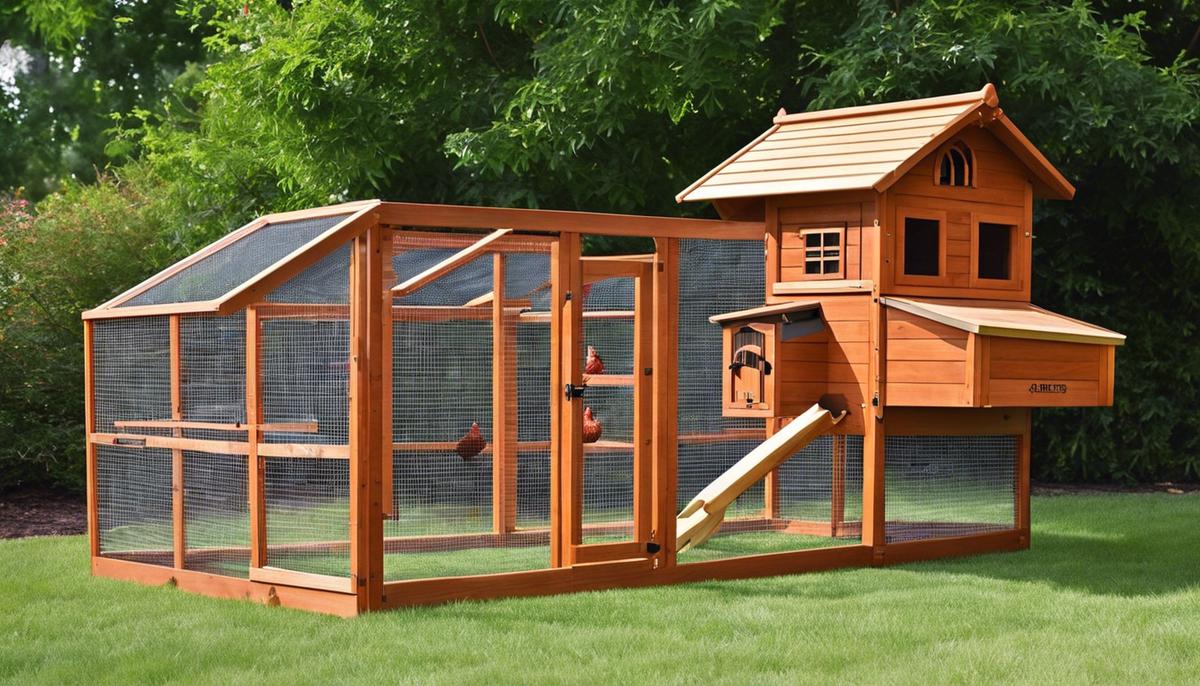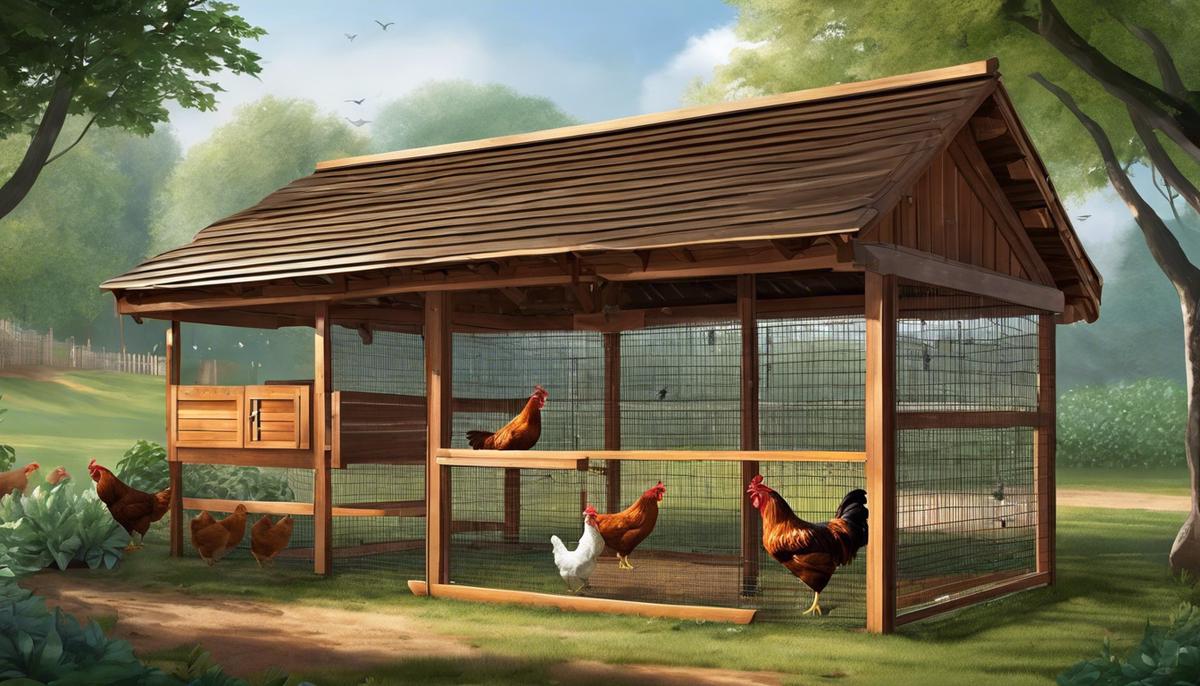
Chicken runs | Step by Step
Description: Chicken farming has gained popularity over the years due to its numerous benefits, including the provision of fresh eggs and meat, as well as organic waste useful for gardening. One critical aspect of raising chickens is providing them with a properly constructed run. Building a chicken run entails a comprehensive understanding of the most suitable locations and the influence of different factors such as space, predators, sunlight, and fresh pasture. Moreover, planning and designing the run optimally requires consideration of material choices, size decisions, and entrance planning, essential for ensuring easy cleaning and feeding operations. Lastly, the construction process, which involves creating a secure and conducive environment for the chickens, stands as a crucial step in their overall welfare. If we're talking about joys combined with challenges, chicken-keeping would most definitely top the list — a craft honed only by love, perseverance, and time. One of the primary areas of focus and constant puzzle-solving in chicken-keeping relates to chicken runs — the open-air playgrounds are crucial for the health and temperament of our feathery little friends. While crafting these spaces, one needs to factor in multiple elements — safety, space, sunlight and more. So, let's fluff our feathers and dive into the detailed exploration of perfect areas for chicken runs. First and foremost, consider space — a crucial factor and the starting point of any chicken run plan. An ideal chicken run should provide at least ten square feet per bird, ensuring hens have enough room to roam, scratch, and stretch their wings. Locate a spacious area in your backyard or property ideal for this. Next, comes safety — a prevalent concern for every chicken keeper. Choose an area that's readily visible from the most frequently occupied parts of your house. This vision line will enable you to keep an eye on your roost's activities, warding off any potential predators or addressing any outbreaks of chicken conflict. Sunlight plays an enormous role in the well-being and behavior of chickens. Regular sunlight exposure aids in better egg production, keeps the feathered friends healthy, and boosts their overall mood. Therefore, plan the run in a region where daytime access to light is unhindered. At the same time, avoid overly exposed areas to protect the birds from too much heat. Chickens value their shady spots, so ensure there's a good mix of sun and shade. When plotting the location, think about the rain and wind direction in your area. Place the chicken run on high ground to avoid waterlogging in the event of heavy rain. Incorporate natural windbreaks into the run's design using existing buildings, trees, or bushes. This strategy prevents the run from turning into a wind tunnel, causing distress to our clucky companions. Proximity to your house is an underplayed yet significant aspect. Having the run close makes it easier to take out food scraps, collect eggs, and do regular surveillance checks. However, one needs to consider their neighbors and local restrictions, as some places have rules about how close the chicken quarters can be to human living spaces. And finally, to ensure a continually rich life for our feathery residents, rotate regions if possible. Rotation prevents the over-wearing of one section of your garden, while also supplying fresh ground for the hens to scratch and peck at, a natural behavior that keeps them joyful. Settling on the best spot for a chicken run taps into enthusiasts' knowledge, understanding of their surroundings, a touch of creativity, and heaps of love for these charming creatures. It is an ongoing journey, and with each chicken run you build, you will find yourself becoming a better, more empathetic chicken keeper — truly a testament to the beauty of this hobby. 'Chicken Keeping' is not just a hobby—it's a delightful journey filled with fresh eggs, endearing clucks, and lively behaviors that grace our backyard. Be it the lively Egg-Layer or the gorgeous Sapphire Gem, a well-designed chicken run can significantly impact your birds' quality of life, productivity, and overall happiness. And that's what we will focus on today. Now, you might be wondering, you've caught the basics of chicken runs from our previous posts, so what's next? Breathe in the crisp country air because we're diving right into the advanced nuances to create your ultimate chicken run! Right from the get-go, sizing the run is an integral focus. While we’ve underlined the vitality of open space in the previous part of the article, calculating optimal space remains significant. For medium-sized birds, allot 8-10 square feet per chicken, but adjust the ratio for smaller or larger breeds. Allow for extra room to accommodate functionalities like dust baths or feeding areas, because these spaces are the social hubs for your peppy flock. Variety is the spice of chicken life, just like ours. Including diverse elements in run construction helps keep chickens stimulated. Try incorporating perches at different heights. Include things like stumps, ladders, or even old chairs. These create dynamic vertical spaces, effectively utilizing the run area and offering ample perching spots. Remember, redundancy could lead to squabbles! Covering the run with a strong material like welded wire or hardware cloth is vital. It serves to protect from aerial predators while offering ventilation. Laying a base layer of wire mesh prevents digging animals from tunneling in. You could also consider a roofed area. It serves as a cooling shade on hot summer days and a dry spot during rain spells keeping the coop environment-friendly and cozy. Now, on to a lesser-discussed but significant aspect—natural chicken behavior. Chickens love to scratch and peck at the ground. Unfortunately, a confined run can quickly turn bare. Introduce a method called deep litter, wherein organic material like straw, leaves or wood shavings will control odor, promote beneficial insects, and turn into a compost heap, courtesy of your chicken’s scratching. Last but not least—flock dynamics. Observation is key in a chicken keeper's life. Monitor how your birds behave around each other. Are they fighting for space on perches? Bickering at feeders? Adjust and adapt to their needs. As your flock grows and changes, your run should evolve too. Creating the perfect chicken run doesn't end once the construction is done: it is an ongoing process of learning and tuning to keep your backyard warriors happy and healthy. After all, in the zestful world of chicken keeping, there's always room for growth, change, and better clucks! Firstly, design plays a major role in the construction of a chicken run. Aim for a rectangular layout for the run. This eases wire installation and supports the overall health of the flock by creating a more navigable environment. But, stay flexible. Adapt the design to the landscape and the unique needs of your chickens. Remember, this isn't a one-size-fits-all hobby! When it comes to materials, durability is key. For your primary construction, consider pressure-treated timber or upcycled pallet wood. Both are cost-effective and resilient against the elements. For the roof, solid coverings give excellent protection against weather and predators. Yet, including sections of poultry wire promotes ventilation and allows the chickens to enjoy the sky above. Let's talk fencing! As previously mentioned, welded wire or hardware cloth make excellent choices, with the latter having the upper hand when warding off smaller predators. The rule of thumb is to bury the fence at least 12 inches into the ground to deter digging threats. Consider adding a one to two-foot apron on the ground outward from the fence, secured with landscaping pins. This makes even the most ambitious predators think twice! Gate design needs to be at the forefront of your thoughts too. An inward opening gate prevents playful chickens from barging their way to freedom when you are entering or leaving. Adding a double gate system offers an additional layer of security. Chickens are lively creatures and need a stimulating environment. Incorporate perches at various levels for your feathered friends to roost and observe their surroundings. You might also add a dust bath area filled with sand and soil for them to indulge in one of their favorite activities; such small considerations can enhance chicken happiness immensely. Now, onto deep litter. The deep litter method sees chicken droppings turning into compost right in the run, mitigating smells and attracting beneficial insects for the chooks to snack on. For this, maintain a layer of carbon-rich material (like straw or wood shavings) about six inches deep in the run. The chickens will do the turning." Ever witnessed a chicken having a brawl? Fights among flock members can be serious business. Creating visual barriers within the run using pallets or shrubbery can break the line of sight and prevent conflicts. Remember, the journey of a chicken keeper is one of continuous learning and adjusting. Each flock has unique quirks, and part of the joy is growing with them, refining the run to fit their changing needs. Each improvement you make is stepping further into the incredible world of chickens. Therefore, it's paramount for any aspiring chicken farmer to thoroughly understand the intricacies of building a chicken run. A run that satisfies the requirements of location and design not only upholds the health, safety, and productivity of the chickens, but also eases the cleaning and feeding operations for the farmer. Furthermore, practical knowledge of the construction process is pivotal in preventing predator attacks and ensuring the chickens thrive in a conducive environment. Indeed, a well-constructed chicken run stands as a testament to responsible and successful chicken farming.Chicken runs
Selecting the Location
Coop Corners: Discovering the Best Areas for a Chicken Run

Designing and Planning the Chicken Run
Creating the Perfect Chicken Run: Expert Strategies for a Thriving Flock

Building the Chicken Run
With the basics of chicken run planning covered, let's delve further into the actual construction practices that will lead to a thriving chicken run.
